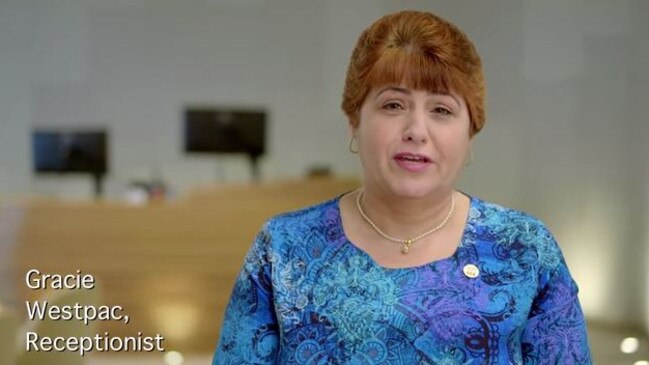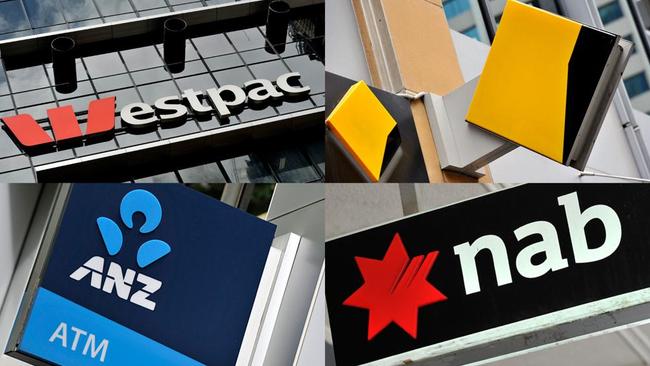For sheer hubris it’s hard to go past the “Australian Banks Belong to You” campaign — the Australian Bankers Association effort to soothe community anger against banks during a potentially incendiary royal commission.
You would have had to have lived under a rock not to have been reassured by Gracie, a Westpac receptionist for 33 years, that banks don’t keep all their profit: “Nearly 80 per cent go back to shareholders. The majority of those shareholders are everyday Australians.”
“Australian bank profits belong to Australians,” chimes in Jake, a home-loan specialist at SA Bank, while Wesley, a branch manager at National Australia Bank, tells us that the profits go to “everyday Australians”.
It seems former Labor PM Ben Chifley, who wished to nationalise the banks, has received his wish. The idea “our” banks “belong” to “everyday Australians”, which presumably means people of ordinary incomes, is a stretch. For a start, a big chunk of the banks is foreign-owned. Working out how much exactly is tricky because owners are concealed by various nominee companies, which hold shares on behalf of individuals and institutions. But the Australian Bureau of Statistics, in an ad hoc study, said this share hovered between 24 per cent and 26 per cent between 2002 and 2006, a bit lower than the average share for all listed firms. I doubt it’s dropped much since then.
So that leaves the bulk of profits going to “everyday Australians”, via their superannuation? Not quite. The median super balance in 2016 for a 50-year-old was $67,000, according to the Australian Super Fund Association.

About a quarter of most people’s super is invested in the local stockmarket and banks make up about a fifth of it. So that implies the “everyday Australian” aged 50 has amassed maybe $3000 worth of bank shares, which might generate $300 a year in dividends at best. And that’s a median 50-year-old, not a 30-year-old in the bottom fifth of his cohort. Indeed, about a quarter of men and a third of women reported having zero super in 2016, according to ASFA.
The profits of the big four banks, about $42 billion last year before tax, flow largely to a concentrated group of domestic and international shareholders. There’s nothing wrong or unusual about that, but it’s a bit rich to be implying there’s anything remotely communal about their ownership.
The campaign also takes advantage of any confusion among the public between profits, revenue and costs. “The banks don’t keep it,” says a smiling Subra, from ANZ, referring to profits. Indeed, the banks might not, but bankers do. Their pay comes out of revenue before a cent gets to shareholders. Westpac spent $4.7bn on salaries and bonuses last year, or an average of $121,000 for each of its employees. I’d guess that Gracie and the vast bulk of the bank’s staff aren’t on anything remotely like that. Ignoring banks’ costs and revenues is to ignore almost everything that’s economically interesting about them.

Discontent about banks is not generated by Gracie, Wesley or Subra, but rather the market manipulation and gouging by senior staff whose ultimate product — money — is state-created and sanctioned. Moreover, implicit state backing means banks’ borrowing costs are held down lower than they would otherwise be, a tidy subsidy to executives and shareholders alike.
I would have preferred an ABA television update on whether NAB is back together with the other three banks. Remember how it spectacularly “broke them up” a few years back? I checked yesterday, though, and the fees and charges were very similar to the others.
For instance, I wish Gracie could have explained why all four major banks charge their customers a 3 per cent “foreign exchange” fee on the value of their credit and debit card purchases, which makes about $640 million a year, when it costs the bank essentially nothing to provide the service.
The ABA could instead have funded a campaign to inform Australians about a genuinely good news story: how soon customers can use the new payments platform. Remarkably, after almost six years of preparation, it seems only the Commonwealth Bank among the majors has bothered to allow all its customers to use the NPP straight away, a piece of new national infrastructure that will allow customers to transfer money to each other immediately and simply using their mobile number or email.
That the major banks had to be dragged kicking and screaming to build this new payment system — the Reserve Bank effectively threatened to do it without them — suggests a reason why. The NPP could ultimately see control of the payments system wrested off the major banks. It might even make it easier to change bank accounts. Some smaller fintech firms are already complaining they will struggle to connect to the NPP because they can’t do so without the de facto agreement of the banks that own the NPP (along with the RBA).

The long-run interests of banks won’t be served by television campaigns that stretch the truth. They would be better served by cutting their fees and charges and drawing attention to the fact.
CBA’s decision to axe foreign ATM fees, quickly replicated by the others, was a win for consumers. But it cost the banks relatively little because ATMs are being used less and less anyway. Scrapping or dramatically reducing penalty and late payment fees on overdrawn accounts, which bear almost zero relationship with the actual cost to the bank of these “services”, would be another good step.
If banks were run like utilities none of these sorts of sneaky excessive fees would exist. But returns would be far lower for shareholders, including “everyday Australians”. The dilemma is fundamental and probably insoluble. So long as management is motivated in large part by rate-of-return targets, the incentives of the institution will be to act in ways that don’t ensure the industry respects the public. The royal commission must grapple with this question as it ponders how to reduce the likelihood of misconduct in financial institutions.




To join the conversation, please log in. Don't have an account? Register
Join the conversation, you are commenting as Logout